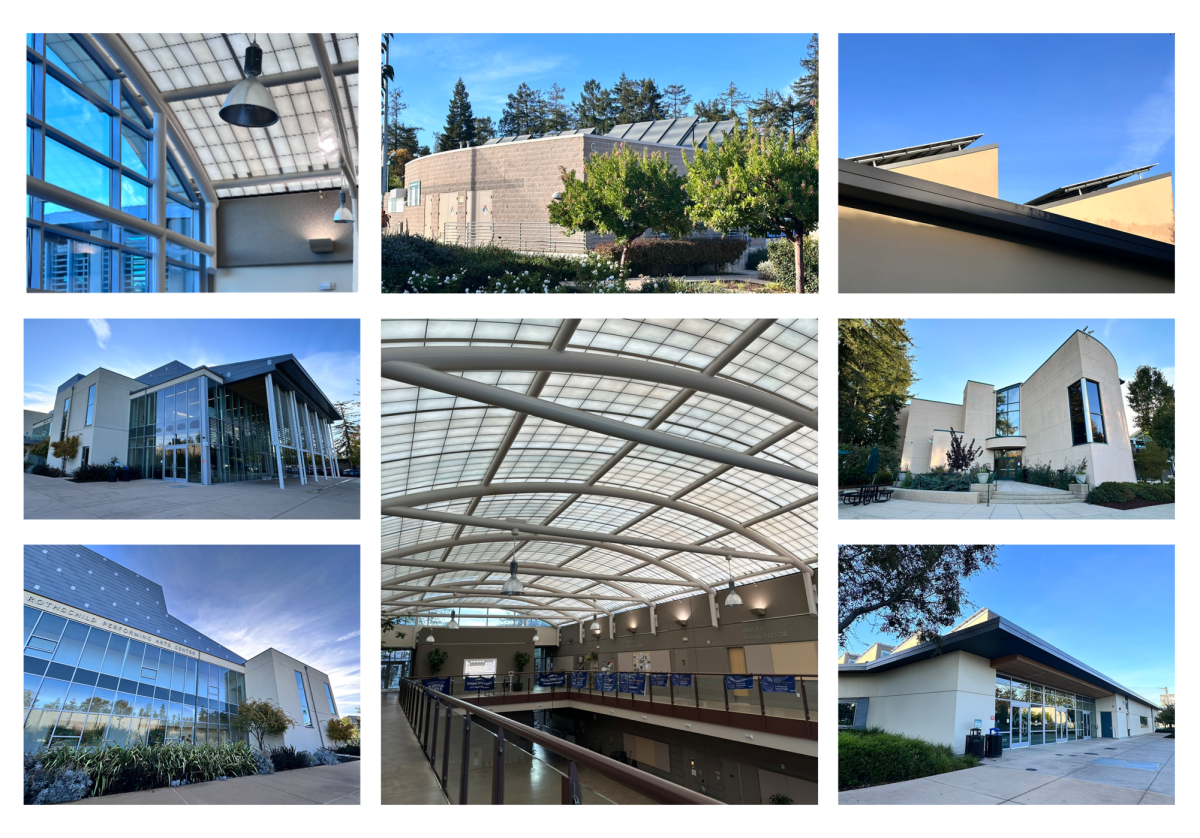With a 1.7-acre AstroTurf field, 11 buildings, 79 classrooms and labs, the upper school campus offers numerous facilities for student academic exploration and athletic training. Harker’s facilities consume large amounts of energy: 2,000 kilowatt-hours every day in the summer to over 5,000 kilowatt-hours in the fall. The electricity Harker uses equates to dozens to hundreds of times that of an average American household.
Harker utilizes electricity via San Jose Clean Energy’s GreenSource service. 60% of the power comes from renewable energy and 24% is drawn from non-renewable carbon-free sources like hydropower and nuclear energy. Solar panels on the roofs of Nichols Hall, the Rothschild Performing Arts Center and the Zhang Gymnasium also produce energy, and the Singh Aquatic Center uses solar energy to heat water used in pool facilities.
“Every energy source that we use has an environmental impact,” AP Environmental Science teacher Jeff Sutton said. “You have to mine to make the materials for solar panels; alter rivers, put in dams and mine to make the turbines for hydropower; and same with the windmills. But once solar, wind and hydroelectric energy sources are up and running, they have very minimal carbon output.”
Compared to other buildings, Nichols Hall uses the most electricity because of its vaulted ceiling and spacious atrium. Since hot air rises, heating systems must fill the entire atrium from top to bottom so that students on the ground floor can feel the warmer air. However, Nichols Hall also matches the LEED Gold certification standards set for green buildings by the U.S. Green Building Council. As a result, the rooms, atrium and auditorium in Nichols Hall implements environmentally friendly practices in energy, water usage and waste.
Buildings across the U.S. consume large amounts of energy for heating, cooling, lighting and other needs, constituting 40% of total energy used in the U.S., 75% of electricity usage and 35% of carbon emissions, according to the National Renewable Energy Laboratory. This makes infrastructure energy a significant contributor to global warming.
“Right now, the two main emitters of greenhouse gasses are transportation and buildings, so infrastructure just contributes a ton,” Green Team President Eric Zhang (12) said. “Heating uses the most energy in buildings and contributes to the most greenhouse gas emissions.”
To minimize unnecessary energy use, rooms and facilities include building management systems that automatically control heating and air conditioning, which serve as the biggest energy saver throughout the campus.

“We very proactively manage our heating and air systems,” Director of Facilities Shayne Hale said. “A classroom in Nichols Hall will shut off when school gets out. Those systems will not run through the weekend or at holiday times, so the buildings are smart and know the schedule. Some also have sensors that will know if the teacher has the door propped open for a long time and will shut the system down.”
Older structures including Manzanita Hall and the Main Academic Building will be rebuilt in the next few years. New buildings will include state-of-the-art technologies to maximize energy efficiency under the California Code of Regulations’ lighting standards for commercial buildings.
“Building standards require ultra-efficient finishes, insulation and lighting,” Hale said. “If there’s a lot of natural light, the interior lighting will reduce, and if it’s very bright, it’ll turn itself off with sensors. New buildings will also have solar.”
The newly constructed buildings will also sell excess solar energy back onto the grid and store it to provide electricity for outlets, which may be helpful during power outages. The facilities team also plans to replace mercury-containing fluorescent lighting, used extensively in Main, with LEDs in all buildings. In the meantime, Hale advised students to help the school save energy by being conscious of any unnecessary power usage.
“Just be mindful when you leave a room and flip the light switch off if the room doesn’t have a sensor,” Hale said. “If you see lights that are on at times that they shouldn’t be, it would be nice to let one of the facilities folks know so that they can turn it off. That’ll help us keep better tabs.”


















![“[Building nerf blasters] became this outlet of creativity for me that hasn't been matched by anything else. The process [of] making a build complete to your desire is such a painstakingly difficult process, but I've had to learn from [the skills needed from] soldering to proper painting. There's so many different options for everything, if you think about it, it exists. The best part is [that] if it doesn't exist, you can build it yourself," Ishaan Parate said.](https://harkeraquila.com/wp-content/uploads/2022/08/DSC_8149-900x604.jpg)




![“When I came into high school, I was ready to be a follower. But DECA was a game changer for me. It helped me overcome my fear of public speaking, and it's played such a major role in who I've become today. To be able to successfully lead a chapter of 150 students, an officer team and be one of the upperclassmen I once really admired is something I'm [really] proud of,” Anvitha Tummala ('21) said.](https://harkeraquila.com/wp-content/uploads/2021/07/Screen-Shot-2021-07-25-at-9.50.05-AM-900x594.png)







![“I think getting up in the morning and having a sense of purpose [is exciting]. I think without a certain amount of drive, life is kind of obsolete and mundane, and I think having that every single day is what makes each day unique and kind of makes life exciting,” Neymika Jain (12) said.](https://harkeraquila.com/wp-content/uploads/2017/06/Screen-Shot-2017-06-03-at-4.54.16-PM.png)








![“My slogan is ‘slow feet, don’t eat, and I’m hungry.’ You need to run fast to get where you are–you aren't going to get those championships if you aren't fast,” Angel Cervantes (12) said. “I want to do well in school on my tests and in track and win championships for my team. I live by that, [and] I can do that anywhere: in the classroom or on the field.”](https://harkeraquila.com/wp-content/uploads/2018/06/DSC5146-900x601.jpg)
![“[Volleyball has] taught me how to fall correctly, and another thing it taught is that you don’t have to be the best at something to be good at it. If you just hit the ball in a smart way, then it still scores points and you’re good at it. You could be a background player and still make a much bigger impact on the team than you would think,” Anya Gert (’20) said.](https://harkeraquila.com/wp-content/uploads/2020/06/AnnaGert_JinTuan_HoHPhotoEdited-600x900.jpeg)

![“I'm not nearly there yet, but [my confidence has] definitely been getting better since I was pretty shy and timid coming into Harker my freshman year. I know that there's a lot of people that are really confident in what they do, and I really admire them. Everyone's so driven and that has really pushed me to kind of try to find my own place in high school and be more confident,” Alyssa Huang (’20) said.](https://harkeraquila.com/wp-content/uploads/2020/06/AlyssaHuang_EmilyChen_HoHPhoto-900x749.jpeg)








